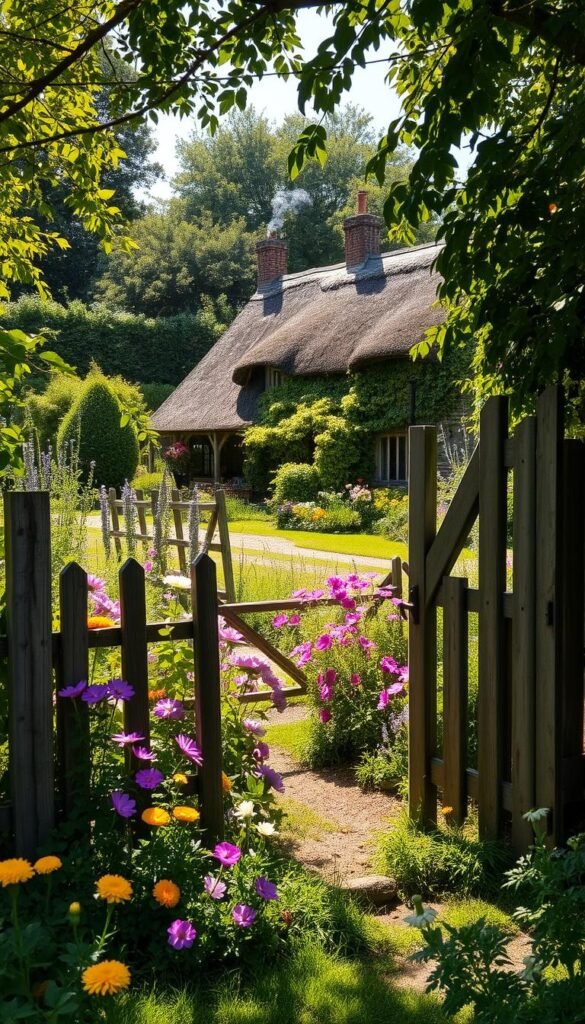Imagine stepping into a space where flowers tumble over pathways and herbs mingle with vegetables. This is the magic of a relaxed planting style rooted in centuries-old traditions. Born in rural England over a thousand years ago, these informal landscapes began as practical plots for growing food and medicine.
What makes this approach special? It’s not about perfect rows or strict rules. Instead, it celebrates nature’s quirks – think daisies peeking through lavender or tomatoes sharing soil with roses. You’ll find joy in mixing textures and colors while letting plants grow where they thrive naturally.
This philosophy welcomes everyone. Whether you’re new to gardening or have years of experience, creating your own vibrant oasis becomes an act of self-expression. The secret lies in balancing wild beauty with purpose, blending edible and ornamental plants in ways that feel both spontaneous and intentional.
Ready to transform your outdoor area? Discover how historical wisdom meets modern creativity in designs that nourish both body and soul. Let’s explore how to craft spaces that whisper stories of simpler times while fitting seamlessly into contemporary life.
Introduction to a Cottage Garden
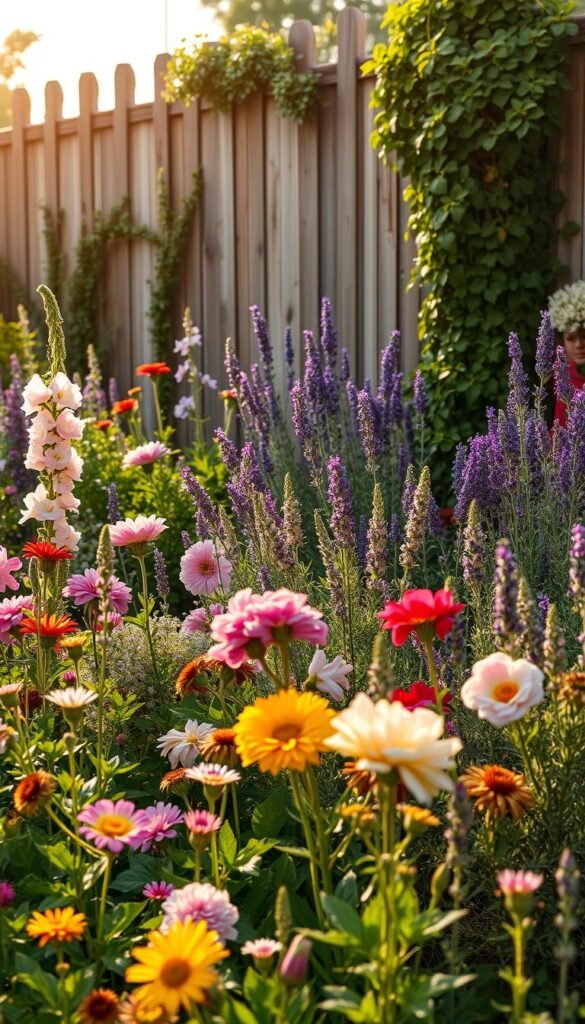
Step into a living canvas where every plant has its purpose and charm. A traditional cottage garden thrives on joyful chaos, with roses climbing weathered fences and lavender brushing against vegetable patches. These spaces feel both timeless and personal, blending practical needs with natural artistry.
You’ll find classic favorites like foxgloves and daisies mingling with fragrant herbs. “A garden should feed more than just your eyes,” says one seasoned grower, highlighting how thyme and rosemary add flavor to meals while attracting pollinators. Stone pathways and vintage bird baths serve as anchors in this floral whirlwind.
| Traditional Elements | Modern Adaptations |
|---|---|
| Roses & foxgloves | Drought-resistant blooms |
| White picket fences | Recycled metal edging |
| Mixed herb beds | Vertical herb gardens |
What makes these spaces special? They balance wild beauty with function. Mint tumbles onto walkways, while sunflowers tower over lettuce rows. This approach works in small yards or sprawling plots – it’s about attitude, not acreage.
Ready to blend whimsy with practicality? Explore how the cottagecore aesthetic can transform your outdoor area into a living storybook. Start by planting one cheerful corner and let nature guide the rest.
Cottage Garden Aesthetic: Bringing Cozy Countryside Charm to Your Backyard
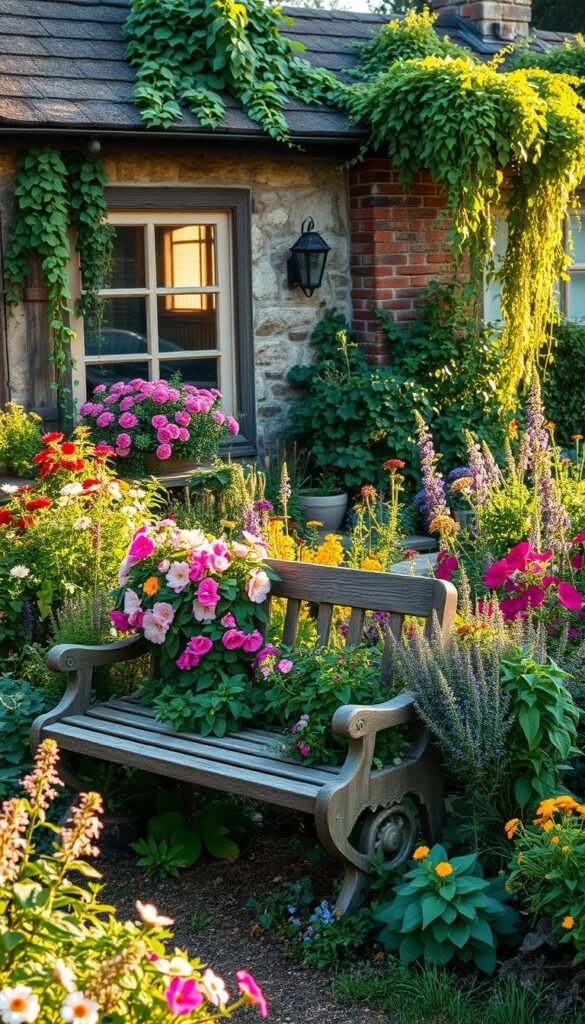
Picture a landscape where every stone and stem tells a story. These spaces thrive on natural collaboration – think weathered walls hosting moss colonies while clematis vines dance across aged wood. Instead of rigid layouts, plants choose their favorite spots, creating layered textures that change with the seasons.
Romantic details define this style. Peek through archways draped in honeysuckle to discover clusters of peonies and delphiniums. “The magic happens when blooms appear to self-seed,” notes landscape designer Emma Green, highlighting how foxgloves might surprise you by sprouting near your patio. Fragrant herbs like lemon balm mingle with old-fashioned roses, creating scent trails that shift with the breeze.
| Traditional Features | Modern Twists |
|---|---|
| Heirloom roses | Disease-resistant varieties |
| Rustic stone paths | Permeable gravel walkways |
| Wildflower meadows | Pollinator-friendly natives |
Vertical layers add depth to your design. Train sweet peas up birch poles or let nasturtiums cascade from hanging baskets. This upward growth draws the eye while saving ground space for low-growing thyme or alpine strawberries.
The secret lies in curated randomness. Group three foxgloves together here, let columbines cluster there – but leave breathing room between textures. Mix feathery dill fronds with velvety lamb’s ear leaves for tactile contrast that invites touch.
Embrace imperfections as part of the charm. A leaning trellis or uneven brick edging adds character, proving beauty doesn’t require precision. Your space becomes a living scrapbook, evolving with each year’s successes and happy accidents.
The Origins and Inspiration Behind Cottage Gardens
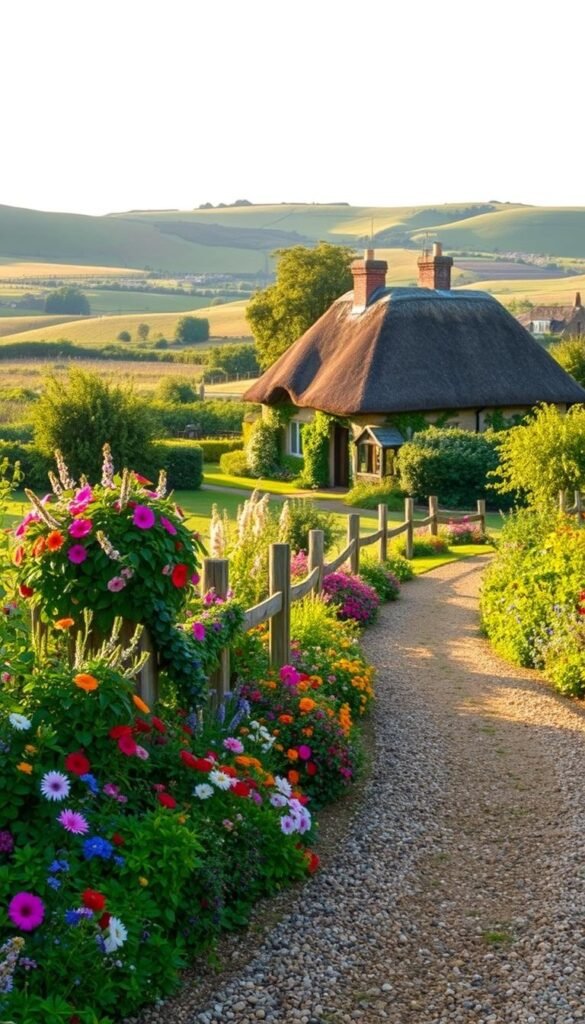
Centuries before modern landscaping trends, rural families cultivated practical plots teeming with life. These early cottage gardens emerged in England around 980 AD, serving as multi-purpose spaces where beauty and utility grew side by side. Stone boundaries marked small properties where every plant earned its place through hard work and flavor.
“Medieval growers didn’t separate flowers from food,” explains designer Tracy Foster. “Rosemary flavored stews while attracting bees, and calendula healed scrapes before brightening bouquets.”
The original layouts maximized limited space through clever layering. Fruit trees shaded root vegetables, while climbing beans used fence posts as natural trellises. This approach created self-sustaining ecosystems where nothing went to waste.
| Historical Purpose | Modern Adaptation |
|---|---|
| Compact food production | Decorative edible borders |
| Medicinal herb patches | Aromatic sensory gardens |
| Recycled materials | Upcycled planters |
Over 1,000 years, these practical plots evolved into the traditional cottage style we admire today. Working-class families transformed necessities into art, weaving roses through bean poles and lining paths with thyme. Their legacy teaches us that functionality and charm aren’t opposites – they’re natural partners.
Today’s versions honor this heritage while adapting to urban spaces. Window boxes burst with strawberries and pansies, echoing the spirit of those medieval multitaskers. By blending old wisdom with new needs, we keep a rich horticultural tradition alive.
Key Elements and Features of a Traditional Cottage Garden
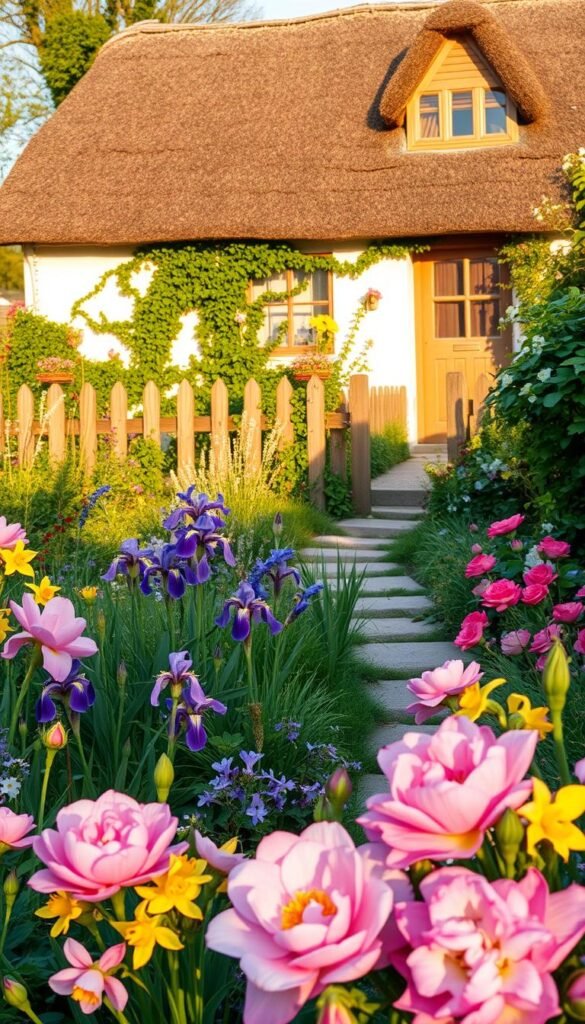
Forget straight lines and perfect symmetry – traditional cottage gardens thrive on joyful spontaneity. Plants mingle freely, with hollyhocks brushing against sage and daisies peeking through thyme. This approach celebrates nature’s rhythms rather than human-imposed order.
Spacing follows nature’s blueprint. Let taller blooms like delphiniums rise behind low-growing herbs without strict measurements. “The best arrangements happen when you let plants choose their neighbors,” says horticulturist Mia Carter. This creates layered textures that change weekly as different species bloom.
| Traditional Approach | Modern Benefit |
|---|---|
| Random plant placement | Supports biodiversity |
| Mixed heights | Creates visual interest |
| Self-seeding flowers | Reduces maintenance |
Imperfection isn’t just allowed – it’s essential. A slightly overgrown path lined with violets or mint escaping its bed adds authentic character. These “flaws” become habitats for butterflies and hummingbirds that pollinate your space.
Wildlife thrives in this carefully curated chaos. Dense foliage shelters beneficial insects, while seed heads feed finches through winter. You’ll create a living ecosystem that feels both cultivated and wonderfully untamed.
This style invites personal touches. Tuck a vintage watering can among your roses or let morning glories climb an old ladder. Your space becomes a reflection of your story, growing more charming with each season’s surprises.
Charming Plant and Flower Ideas for Cottage Gardens
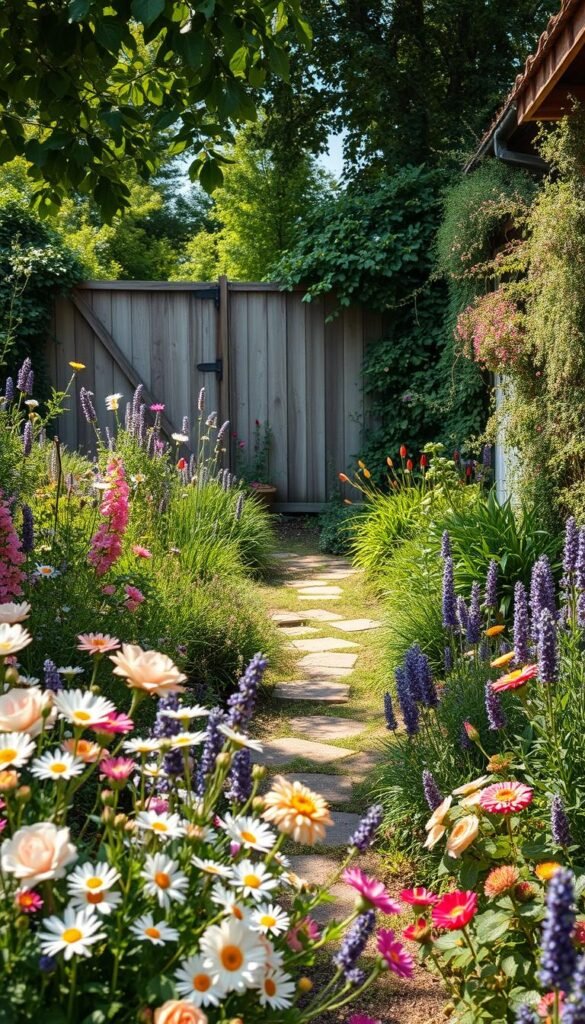
Fill your outdoor space with blooms that tell stories through their colors and scents. Mix towering spires of foxgloves with mounded phlox for vertical drama, then let dahlias anchor beds with their dinner-plate blooms. This layered approach creates depth while inviting pollinators to linger among petals.
Sweet peas and columbines bring airy elegance to borders, their delicate forms contrasting with iris swords. “Roses remain the heart of these spaces,” notes gardener Lila Parks. “Their fragrance and repeat blooms make them worth the extra care.” Pair climbing varieties with clematis for double the floral impact.
| Bloom | Role | Care Level |
|---|---|---|
| Roses | Focal points | Moderate |
| Lavender | Path edging | Easy |
| Zinnias | Color fillers | Low |
| Cosmos | Height builders | Minimal |
Practical beauty shines with lavender borders that release fragrance when brushed. For nonstop color, scatter seeds of black-eyed Susans and coneflowers – they’ll thrive even in poor soil. Let hydrangeas soften corners with their mophead blooms, changing hues based on your soil’s pH.
Remember to leave room for surprises. Self-seeding columbines might pop up between stones, while volunteer sunflowers create natural bird feeders. Your plot becomes a living tapestry that evolves with each season’s rhythm.
Creative Garden Design Ideas and Layouts
What if your outdoor space could reflect your personality? This approach thrives on organic shapes that mirror nature’s flow. Curved pathways winding through flower clusters feel more inviting than straight lines, while irregular planting pockets create surprise at every turn.
Designer Marco Rossi suggests: “Let existing trees or slopes guide your layout – that rocky outcrop becomes a feature, not a flaw.” Work with your land’s quirks instead of flattening them. A sunken area might host shade-loving ferns, while a sunny slope bursts with drought-tolerant blooms.
| Traditional Concept | Modern Adaptation |
|---|---|
| Free-form beds | Raised modular planters |
| Rustic arbors | Geometric trellis art |
| Mixed borders | Color-themed zones |
Small spaces shine with vertical layers. Hang trailing nasturtiums above compact herbs, or train beans up a repurposed ladder. Even balcony railings can support mini clematis vines.
Remember – your plot’s “flaws” add character. That uneven stone wall? Perfect for tucking alpine strawberries into crevices. Your design becomes a conversation between human creativity and nature’s wisdom.
Planning Your Garden Beds and Plant Arrangements
Begin your horticultural journey by focusing on manageable areas. A 4×6 foot plot lets you experiment without feeling swamped. This approach helps you understand sunlight patterns and soil quirks before expanding.
Smart Scaling Strategies
Add one new bed each season while refining existing spaces. Track which plants flourish in your microclimate – maybe lavender thrives near that sunny wall, while ferns prefer shaded corners. This gradual growth builds confidence and reduces wasted effort.
Crafting Intentional Wildness
Create visual flow by grouping plants in odd numbers. Place taller blooms like hollyhocks behind mounding herbs, leaving space for self-seeding annuals to fill gaps. Designer Clara Winters notes: “Successful beds mimic nature’s patterns – clusters that feel random but follow light and water needs.”
| Traditional Method | Modern Solution |
|---|---|
| Hand-drawn sketches | Garden planning apps |
| Trial-and-error planting | Soil moisture sensors |
| Seasonal observations | Digital growth trackers |
Rotate crops annually to maintain soil health. Let mint spill onto walkways while calendula edges vegetable patches. This controlled spontaneity creates habitats for beneficial insects and surprises that keep your space dynamic.
Tips for Successful Garden Soil and Mulching
Healthy soil forms the backbone of any thriving planting space. For a lush, vibrant landscape, start by understanding what lies beneath your feet. Simple steps now create ideal conditions for roots to spread and blooms to flourish.
Conducting a Soil Test
Knowledge is power when nurturing your plot. A $10 test kit reveals pH levels and nutrient gaps – crucial data for choosing amendments. Most flowering varieties thrive in slightly acidic soil (6.0-6.5 pH). If results show imbalances, mix in compost or peat moss to adjust conditions.
Choosing the Right Organic Mulch
Mulch acts as a protective blanket while feeding your ecosystem. Spread 2-3 inches around plants, keeping it away from stems to prevent rot. Different materials offer unique benefits:
| Type | Benefits | Best For |
|---|---|---|
| Bark chips | Long-lasting weed control | Pathways & shrubs |
| Compost | Instant nutrients | Vegetable beds |
| Leaf mold | Improves soil structure | Flower borders |
Refresh mulch annually as it decomposes. For budget-friendly options, try making your own compost from kitchen scraps and yard waste. Combined with proper soil prep, these techniques reduce watering by 30% while keeping beds tidy.
Want to dive deeper? Explore organic soil-building strategies that support robust growth year after year. Your efforts today will reward you with healthier plants and fewer chores tomorrow.
Growing and Maintaining Your Cottage Garden
While your flowering oasis might seem carefree, keeping it thriving demands smart strategies. Regular deadheading becomes your secret weapon – snipping spent blooms redirects energy to new buds and prevents plants from going to seed too early. This simple habit extends your floral display while keeping borders tidy.
Established perennials need attention too. Divide overcrowded clumps every 3-4 years using a sharp spade. “This rejuvenates older plants and creates free starters for new beds,” advises master gardener Henry Mills. Early spring or fall works best for this task, giving roots time to settle before extreme weather.
| Maintenance Task | Frequency | Key Benefit |
|---|---|---|
| Deadheading flowers | Weekly | Encourages repeat blooms |
| Dividing perennials | Biennial | Prevents overcrowding |
| Soil amendment | Annual | Boosts plant health |
Balance is crucial in these lush spaces. Vigorous growers like mint or bee balm can overwhelm delicate neighbors if left unchecked. Create natural barriers by planting assertive varieties in buried containers or designated zones.
Smart planning reduces chores without sacrificing charm. Pair self-seeding annuals like poppies with structured shrubs that anchor the design. Your efforts will pay off in a vibrant, ever-changing landscape that feels wild yet intentional.
Incorporating Edible and Ornamental Plants
Blur the lines between your vegetable patch and flower beds for a space that nourishes both body and soul. This approach lets you harvest fresh ingredients while enjoying vibrant colors and textures. Imagine plucking basil leaves beside blooming zinnias or snacking on cherry tomatoes under climbing roses.
Certain vegetables bring unexpected beauty to your plot. Peas with their delicate tendrils create living trellis art, while ruby-hued kale leaves add dramatic foliage contrast. Alliums like garlic chives double as pest deterrents, their spherical blooms attracting pollinators through summer.
| Vegetable | Visual Features | Harvest Time |
|---|---|---|
| Purple beans | Vibrant vines | Mid-summer |
| Rainbow chard | Colorful stems | All season |
| Globe artichokes | Architectural buds | Late spring |
Herbs form the backbone of this dual-purpose design. Fragrant thyme spills over stone edges, releasing scent when brushed. “Lavender’s gray-green foliage pairs perfectly with roses,” notes gardener Elena Martinez. “It deters deer while drying beautifully for sachets.”
This planting philosophy honors historical roots while maximizing modern spaces. Every plant serves multiple roles – feeding your family, supporting wildlife, and creating visual delight. Your plot becomes a living pantry wrapped in nature’s artistry.
Designing Romantic Garden
Envision a sanctuary where twilight lingers among fragrant blooms and soft textures. Romantic outdoor spaces thrive on sensory experiences – imagine jasmine-scented evenings under climbing roses, or morning light filtering through wisteria-draped arches. These designs prioritize intimacy through curved pathways and tucked-away seating nooks.
Incorporate vintage elements like weathered benches or iron lanterns to evoke timeless elegance. Let nature’s rhythm guide your layout – allow clematis to weave through arbors and lavender to spill onto stepping stones. Soft lighting transforms your space after dark, with solar-powered fairy lights creating star-like accents in foliage.
Focus on multi-season appeal. Early-blooming peonies give way to summer roses, while ornamental grasses add winter texture. Include plants with personal meaning – perhaps your grandmother’s favorite lilac variety or herbs from memorable travels. This approach turns functional areas into emotional anchors that deepen your connection to the land.
Your outdoor retreat becomes a living love letter to beauty in all its imperfect glory. Start small: plant one fragrant vine, add a cozy bench, and watch how nature amplifies your vision. Every thoughtful detail whispers invitation – to linger, dream, and savor life’s quiet moments.

